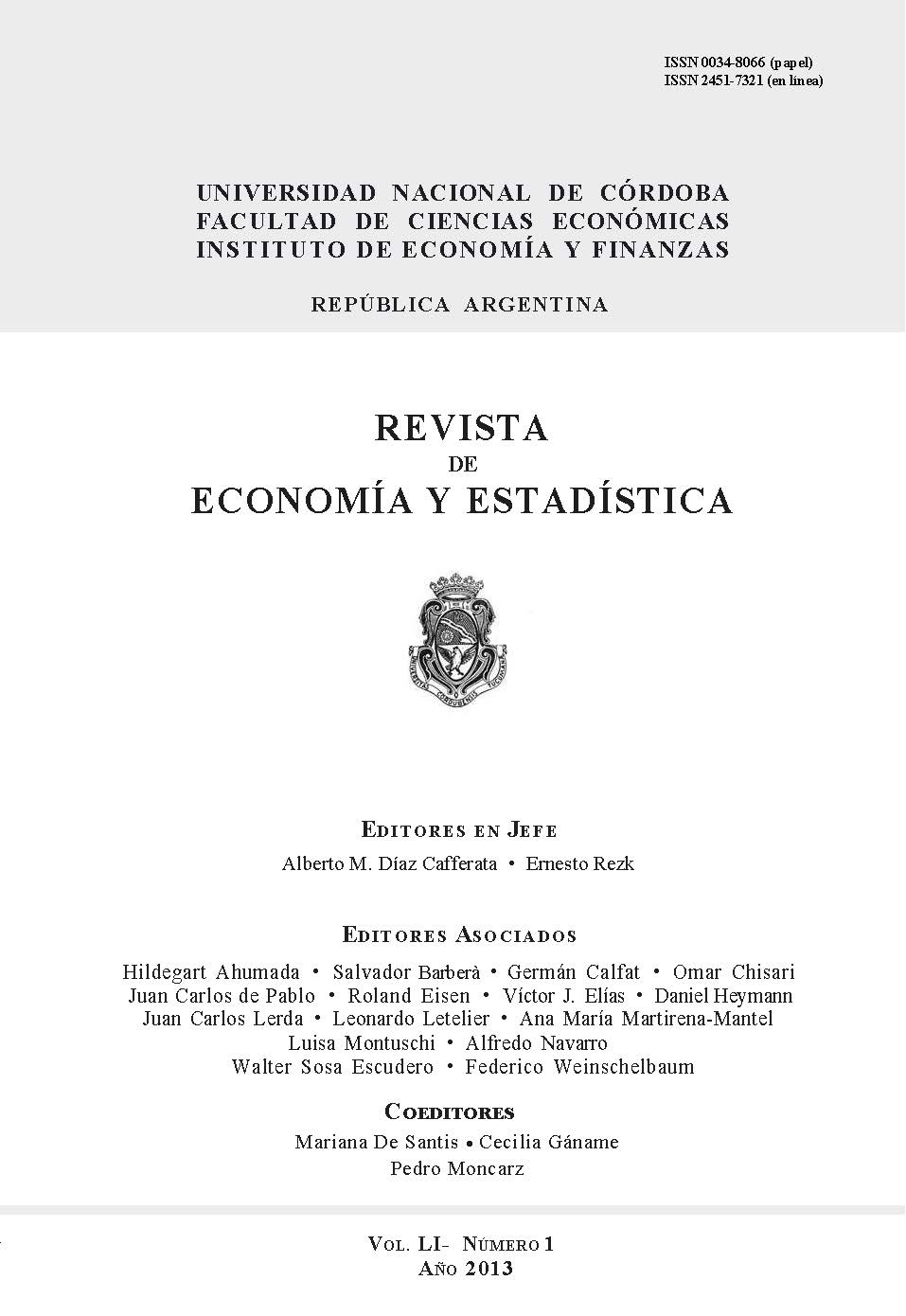Electricity Distribution and Technical Efficiency in Argentina: An Application of Stochastic Frontier Analysis (SFA) using Functions of Distance
DOI:
https://doi.org/10.55444/2451.7321.2013.v51.n1.11877Keywords:
electrical distribution, technical efficiency, distance function, stochastic frontierAbstract
The rate is the most important variable in the complex organization of the regulation of the electricity system, and particularly of the distribution activity. The financial crisis of 2009 and the negative experience of some privatizations internationally together with weak economic literature regarding the ownership / efficiency ratio, revived the debate on analyzing the relationship between public / private ownership of the company and its efficiency technique; measurement of the latter and appropriate regulatory scheme for power distribution. The aim of this paper is to measure the technical efficiency of power distribution companies of Argentina using techniques of distance functions under the framework of stochastic frontier analysis, in order to build a ranking of efficiency between private and public companies.
Downloads
References
Aigner, D., Lovell, C. y Schmidt, P. (1977). “Formulation and Estimation of Stochastic Frontier Production Function Models”. Journal of Econometrics, 6: pp.21-37.
Aigner, D. y Chu, S. (1968). “On Estimating the Industry Production Function”. American Economic Review, 58(4): 826–39.
Atkinson, S., Färe, R. y Primont, D. (1998). “Stochastics Estimation of Firm Inefficiency Using Distance Functions”. Working Paper, Department of Economics, University of Georgia, Athens.
Battese, G. y Coelli, T. (1995). “A Model for Technical Inefficiency Effects in a Stochastic Frontier Production Function for Panel Data”. Empirical Economics, 20: pp.325-332.
Battese, G. y Coelli, T. (1992).“Frontier Production Functions, Technical Efficiency and Panel Data: With Application to Paddy Farmers in India”. Journal of Productivity Analysis, 3, pp. 153-169.
Battese, G., Coelli, T. y Colby, T. (1989). “Estimation of Frontier Production Functions and the Efficiencies of Indian Farms Using Panel Data From ICRISAT's Village Level Studies”. Journal of Quantitative Economics, 5, pp: 327-348.
Battese, G. y Corra, G. (1977). “Estimation of a Production Frontier Model: With Application to the Pastoral Zone of Eastern Australia”. Australian Journal of Agricultural Economics, vol. 21, pp. 169-179.
Burns, P., y Weyman-Jones, T. (1996). “Cost Functions and Cost Efficiency in Electricity Distribution: A Stochastic Frontier Approach”. Bulletin of Economic Research, vol. 48(1), pp. 41-64.
Charnes, A., Cooper, W. y E. Rhodes. (1978).“Measuring the efficiency of Decision Making Units”. European Journal of Operational Research: vol. 2, n. 6, pp. 429-444.
Coelli, T, Rao, P., O’Donnell, C. y Battese, G. (2005). An introduction to efficiency and productivity analysis. New York, Springer.
Coelli, T. & Perelman, S. (2000). “Technical Efficiency of European Railways: A Distance Function Approach”. Applied Economics, vol 32, pp. 1967-1976.
Coelli, T. & Perelman, S. (1999). “A Comparison of Parametric and Non-parametric Distance Functions: With Application to European Railways”. European Journal of Operations Research, vol 117, pp. 326-339.
Coelli, T. (1995). “Estimators and Hypothesis Tests for a Stochastic Frontier Function: A Monte Carlo Analysis”. Journal of Productivity Analysis, vol. 6, pp. 247-268.
Cuesta, R. (2000). “A Production Model With Firm-Specific Temporal Variation in Technical Inefficiency: With Application to Spanish Dairy Farms”. Journal of Productivity Analysis, vol. 13, pp. 139-158.
Danon, M., (2009). “Estimación de Ganancias de Productividad a Través de Funciones Distancias e Fronteras de Producción Estocásticas: Aplicación a Distribuidoras de Energía Eléctrica en Argentina”. XLIV Reunión Anual. Asociación Argentina de Economía Política.
Deprins, D., Simar, L., y Tulkens, H. (1984). “Measuring Labor Inefficiency in Post Offices”, en Marchand, M., Pestieau, P. and Tulkens, H. (eds.) The Performance of Public Enterprizes: Concepts and Measurements: pp. 243-267.
Estache, A., Rossi, M., y Ruzzier, C. (2002). “The case for international coordination of electricity regulation: Evidence from the measurement of efficiency in South America”. World Bank Policy Research Working Paper 2907.
Färe, R. y Primont, D. (1995). Multi-output production and duality: Theory and applications. Kluwer Academis Publishers. London.
Färe, R., Grosskopf, S., Norris, M. y Zhang Z. (1994). “Productivity growth, technical progress, and efficiency change in industrialized countries”. The American Economic Review, vol. 84, n.1, pp. 66-83.
Färe, R., Grosskopf, S., Lindgren, B. y Roos, P. (1994). “Productivity Developments in Swedish Hospitals: A Malmquist Output Index Approach”. En Charnes, A., Cooper, W.W., Lewin, A.Y. y Seiford, L.M. (Eds.). Data Envelopment Analysis: Theory, Methodology and Applications, Boston: Kluwer Academic Publishers: pp. 253–272.
Färe, R., Grosskopf, S. y Lovell, C. (1994). Production Frontier. Cambridge: Cambridge University Press.
Farsi, M., Fetz, A. y Filippini, M. (2007). “Benchmarking and Regulation in the Electricity Distribution Sector”. CEPE Working Paper No. 54.
Greene, W. (2008). Econometric Analysis. 6ta ed. Prentice Hall.
Greene, W.M. (1980). “Maximum likelihood Estimation of Econometric Frontier Functions”. Journal of Econometrics, vol.13, n. 1, pp. 27–56.
Hattori, T. (2002). “Relative Performance of U.S. and Japanese Electricity Distribution: An Application of Stochastic Frontier Analysis”. Journal of Productivity Analysis, vol. 18, pp. 269-282.
Hicks, J. R. (1932). Theory of Wages. London: MacMillan.
Hussain, M; Coelli, T. & Simmons, P. (1999). “An Analysis of the Technical Efficiency of Cotton Farmers in the Punjab province in Pakistan”. Conference (43th), January 20-22, 1999, Christchurch, New Zealand 123815, Australian Agricultural and Resource Economics Society.
Kalirajan, K. (1981). “An econometric analysis of yield variability in paddy production”. Canadian Journal of Agricultural Economics, vol. 29, n. 3, pp 283-294.
Klein, L.R (1953). A textbook of econometrics. New York: Row Peterson.
Kumbhakar, S. y Lovell, K. (2000). Stochastic Frontier Analysis. Cambridge University Press.
Kumbhakar, S. (1990). “Production Frontiers, Panel Data and Time-Varying Technical Inefficiency”. Journal of Econometrics, vol. 46, pp. 201–211.
Loza, A., Margaretic, P. y Romero, C. (2003). “Consistencia de medidas de eficiencia basadas en funciones de distancia paramétricas y no paramétricas. Una aplicación al Sector de Distribuidoras de Electricidad de la Argentina”. XXXVIII Reunión Anual de la Asociación Argentina de Economía Política, Buenos Aires.
Margaretic, P. y Romero, C. (2007). “Estimation of Productive Efficiency based on non-parametric techniques: The case of electricity distribution in Argentina”. En Chisari, O. (Ed.) Regulatory Economics and Quantitative Methods. E.Elgar: Cheltenham, UK.
Melo, L. y Espinosa, N. (2005). “Ineficiencia en la distribución de energía eléctrica: una aplicación de las funciones de distancia estocástica”. Revista Ensayos sobre Política Económica, vol. 49, pp.88-132
Neuberg, L. (1977). “Two Issues in the Municipal Ownership of Electric Distribution Systems”. Bell Journal of Economics, No. 8, pp. 303-323.
Pitt, M. y Lee, L. (1981). “The measurement and sources of technical inefficiency in Indonesian weaving industry”. Journal of Development Economics, 9, pp. 43–64.
Schmidt, P. y Sickles, R.E. (1984). “Production frontiers and panel data”. Journal of Business and Economic Statistics, n. 2, pp. 367–374.
Stevenson, R. (1980). “Likelihood Functions for Generalized Stochastic Frontier Estimation”. Journal of Econometrics, vol. 13, n.1, pp. 58-66.
Downloads
Published
How to Cite
Issue
Section
License
Copyright (c) 2013 Darío Ezequiel Díaz

This work is licensed under a Creative Commons Attribution-NonCommercial-NoDerivatives 4.0 International License.
Authors who have publications with this journal agree to the following terms:
Authors retain their copyright and grant the journal the right of first publication of their work, which is simultaneously subject to the Creative Commons Attribution-NonCommercial-NoDerivatives 4.0 International License that allows third parties to share the work provided that its author and first publication in this journal are indicated.
Authors may adopt other non-exclusive licensing arrangements for distribution of the published version of the work (e.g. depositing it in an institutional telematic archive or publishing it in a monographic volume) as long as the initial publication in this journal is indicated.
Authors are allowed and encouraged to disseminate their work via the Internet (e.g. in institutional telematic archives or on their website) before and during the submission process, which can lead to interesting exchanges and increase citations of the published work. (See The Open Access Effect)









